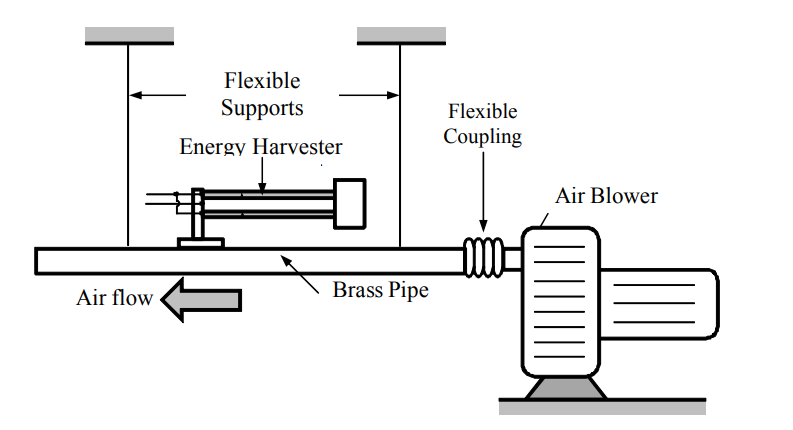Breadcrumb
Improved Semantic Segmentation of Low-Resolution 3D Point Clouds Using Supervised Domain Adaptation
One of the key challenges in applying deep learning to solve real-life problems is the lack of large annotated datasets. Furthermore, for a deep learning model to perform well on the test set, all samples in the training and test sets should be independent and identically distributed (i.i.d.), which means that test samples should be similar to the samples that were used to train the model. In many cases, however, the underlying training and test set distributions are different. In such cases, it is common to adapt the test samples by transforming them to their equivalent counterparts in the

Energy harvesting of gas pipeline vibration
Pipelines conveying gas under pressure exhibit turbulence-induced vibrations. The current work is concerned with extracting useful power from pipelines operating well within their stability region. At such regions, the pipe vibrations exist in small magnitudes and are unlikely to cause structural failure, yet can be exploited to provide useful energy for low-power electronic devices. Accordingly, emphasis in the present work is placed on the development of an energy harvesting technique employing the omnipresent and inevitable flow-induced vibrations in gas pipelines. © 2010 SPIE.

Dynamic behavior and damping characteristics of carbon black polymer composites at high strain rates
The dynamic stress–strain behavior and the damping characteristics of carbon black (CB)/polymer composites at high strain rates are measured using the split Hopkinson pressure bar. These characteristics are determined for polyurethane impregnated with 20% CB nanoparticles and compared with those of pristine polyurethane at strain rates ranging between 2,400 and 7,000 s−1. The obtained results indicate that the CB/polymer composites exhibit highly hysteretic stress–strain characteristics and have high storage modulus as well as high loss factor as compared to pristine polyurethane polymers
Effect of covering irrigation channels on total dissolved solids and total suspended solids
The increase in the evaporation rate is one of the crucial effects of climate change. Water losses due to evaporation are considered as an important challenge that faces the agriculture sector considering the recent water crisis in Egypt. So, covering irrigation canals with the aim to decrease evaporation could be a good solution for this problem, especially if the coverage is expected to be used for power production by covering these canals with solar panels. However, the main concern is the effect of the covering on the quality of water. So, this research study investigates the effect of
Hybrid treatment system for real textile wastewater remediation based on coagulation/flocculation, adsorption and filtration processes: Performance and economic evaluation
This research investigates the feasibility of using hybrid treatment system based on coagulation/flocculation, adsorption and filtration processes for real textile wastewater treatment. Ferric Chloride (FeCl3) was used as a coagulant, Nano Zero-Valent Iron (nZVI) as adsorbent and Micro Zeolite (MZ) as filter media for the removal of chemical oxygen demand (COD), total suspended solids (TSS), color, total nitrogen (TN) and turbidity from raw textile effluents. Batch and continuous feed scaling-up studies (full design and set-up studies) were conducted to evaluate the performance of the

A 3D Multiple-Slip Crystal-Plasticity Model for Precipitate Hardening in Additively Manufactured High Strength Steels
Additive Manufacturing (AM) revolutionized the manufacturing of complex geometry products, especially in medical and aerospace fields. High-strength precipitate hardened (PH) stainless steels provide unique properties in term of strength and corrosion resistance for critical applications in both fields. In the current study, a 3D multiple-slip crystal-plasticity dislocation densities-based model is used to study the effect of copper precipitate hardening in high-strength stainless steels. The proposed approach accurately predicts the complex structure of martensite and properly represents the

Engineered magnetic oxides nanoparticles as efficient sorbents for wastewater remediation: a review
The rapid urbanization and industrialization is causing worldwide water pollution, calling for advanced cleaning methods. For instance, pollutant adsorption on magnetic oxides is efficient and very practical due to the easy separation from solutions by an magnetic field. Here we review the synthesis and performance of magnetic oxides such as iron oxides, spinel ferrites, and perovskite oxides for water remediation. We present structural, optical, and magnetic properties. Magnetic oxides are also promising photocatalysts for the degradation of organic pollutants. Antimicrobial activities and

Comparison of statistical deterioration models for water distribution networks
The use of water main break history as a proxy for condition has become common practice because of the high costs associated with direct assessments. Statistical deterioration models predict future water main breaks on the basis of historical patterns. Many municipalities are beginning to understand the value of utilizing water pipe break histories to manage their noncritical distribution networks via deterioration models. This paper presents a generic IDEF0 process model for developing water main deterioration models. Two common statistical deterioration models for water pipes are compared

Optimizing inspection policies for buried municipal pipe infrastructure
Condition assessment is an integral component in any infrastructure asset management system. Without condition information, asset managers lack the ability to make appropriate decisions regarding needed maintenance, rehabilitation, and replacement of infrastructure. Existing and emerging technologies for assessing the condition of water and sewer pipes provide a better picture of the state of these buried assets. Unfortunately, many of these technologies are costly and provide results that are not always highly reliable. This paper presents a methodology to assist asset managers in balancing
Discrete event simulation tool for earthmoving fleet selection
Earthmoving operations represent a sizable work in heavy civil engineering projects. Selecting optimum fleet configuration for an earthmoving operation is a very difficult process, especially when dealing with a multi loader type and multi truck type configurations. This paper presents a framework that can be used for the selection of optimum fleet for earthmoving operations. It enables the user to input the available loading and hauling equipment, then, it calculates the cost and total project time of each possible fleet combination, and finally it provides a list of the top-ten best fleet
Pagination
- Previous page ‹‹
- Page 3
- Next page ››
